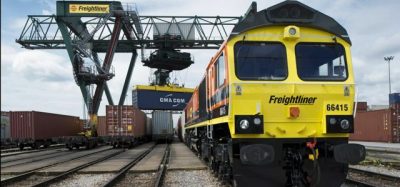TEN-T policy: An impetus to shift to zero‑emission mobility in Europe
Posted: 7 June 2022 | Community for European Railways and Infrastructure Companies (CER), Marina Potapidou | No comments yet
Marina Potapidou, Infrastructure Policy Adviser at the Community for European Railways and Infrastructure Companies (CER), delves into the TEN-T policy and how it has evolved since its introduction almost 10 years ago to become a vital part of Europe’s zero emission aims.


Almost 10 years ago, the Trans‑European Transport Network (TEN-T) policy was introduced and it was a major breakthrough in European infrastructure. It was a smart way to connect Europe and bring people, goods, and businesses closer together. What the current TEN-T policy regulation does is govern this EU policy on transport infrastructure, which notably aims to facilitate transport flows across Member States and support territorial, economic, and social cohesion. It also sets a framework for national and European investments in transport infrastructure and supports focused and efficient funding under the Connecting Europe Facility (CEF) and other relevant EU financing instruments.
At the centre of the TEN-T is the development of a two-layer network structure, consisting of the comprehensive network (implementation horizon 2050) and the core network. The latter represents the most important part of the TEN-T policy on which major European and international transport flows are concentrated and which will be completed by 2030. The TEN-T policy displays coherent infrastructure (technical) standards to ensure interoperability and to avoid operational disruptions (such as for rail full electrification, minimum freight speeds, axle load and nominal track gauge). It covers rail, road, inland waterway, maritime and air transport infrastructure, and multi-modal connections, and it ensures infrastructure equipment provides intelligent and innovative transport solutions.
An increasing focus on sustainability
Now, following a lengthy and comprehensive evaluation since 2018, the TEN-T policy regulation is going through some significant changes. With its current revision and proposal, the TEN-T policy will become more targeted towards greening mobility and making infrastructure more resilient, more accessible, and more efficient. For this, the European Commission (EC) has put forward proposals to enhance and strengthen the current infrastructure requirements for different transport modes.
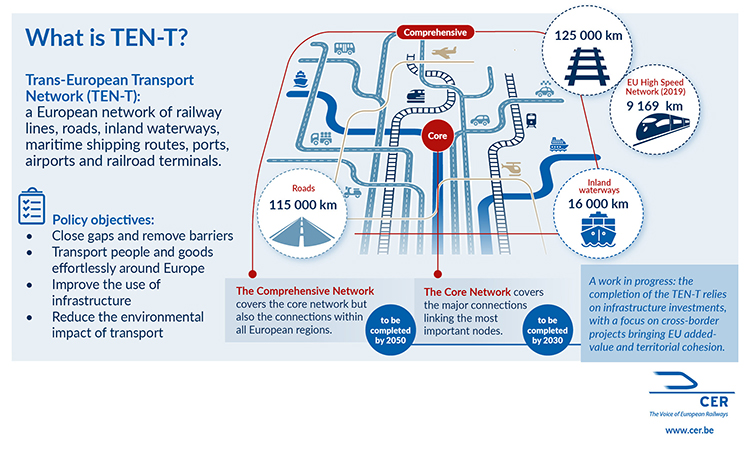

Credit: CER
For railways, the TEN-T is an opportunity to become an even stronger backbone of sustainable mobility. The rail sector believes it is a timely and necessary revision to achieve the European Green Deal’s ambitious climate targets, by ensuring a 90 per cent reduction in transport emissions by 2050.
The proposal includes new introductions such as the extended core network, which includes the core network and some strategic parts of the comprehensive network, setting the deadline for implementation by 2040; the creation of European Transport Corridors (ETCs) through the integration of Core Network Corridors (CNCs) and Rail Freight Corridors (RFCs); new and enhanced infrastructure requirements; accelerated deployment of European Rail Traffic Management System (ERTMS); the further integration of urban nodes into the TEN-T network; the connection with neighbouring third world countries and the development of a resilient infrastructure and innovative technologies. With these proposals, the revised TEN-T regulation represents an improvement of the current situation. However, these ambitious proposals come at a cost.
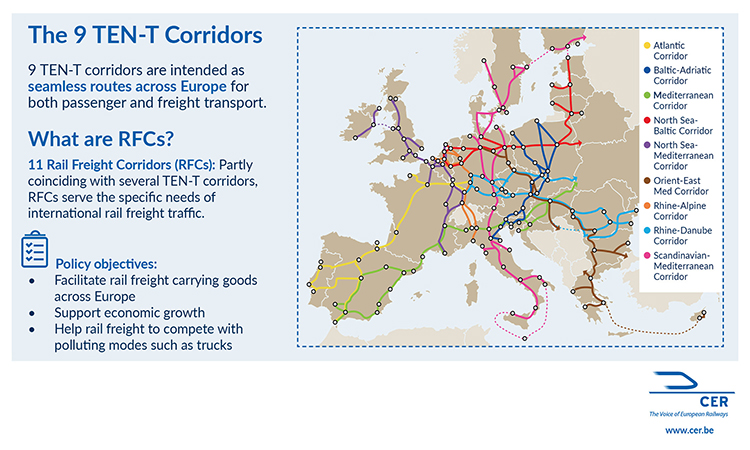

Credit: CER
The need for proper funding
First, sufficient funding is necessary to complete the TEN-T network, including the finalisation of major on-going TEN-T projects, and to support the digital transformation of rail operations, notably on-board and on track ERTMS. The Multiannual Financial Framework (the EU’s long-term budget) includes several financing programmes that provide the co-funding and rail investments for the cross-border rail network or other major rail projects that have EU added value. The CEF is the EU key funding instrument for railway investments. CEF investments fill the missing links in Europe’s energy, transport, and digital networks. Horizon Europe, as the EU’s next funding programme for research and innovation, is also an important tool for the development of rail’s digitalisation activities. The European Regional and Development Fund (ERDF) aims to strengthen economic and social cohesion in the EU by correcting imbalances between its regions. This is an important tool for the completion of the TEN-T and the connection of urban nodes and regions in Europe. The European co-funding tools are there, but the amounts are not sufficient. It is crucial that these new and enhanced requirements and obligations come hand-in-hand with proper and sufficient financing, public or private, to ensure the timely completion of the TEN-T networks. To this end, the next EU financial framework should still cover TEN-T infrastructures beyond the current 2021-2027 budget.
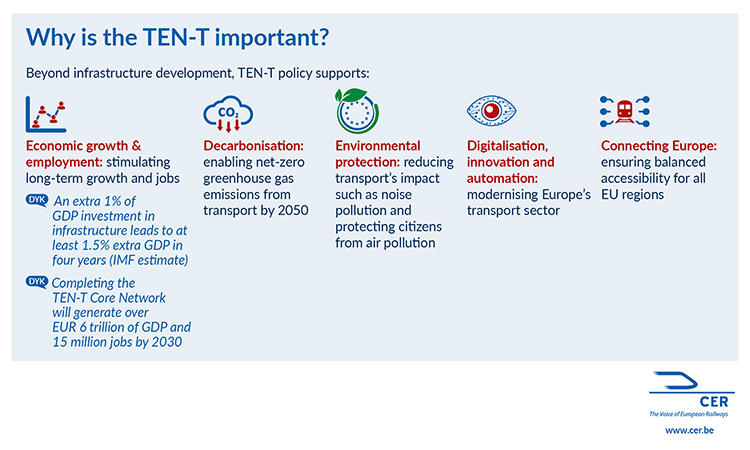

Credit: CER
The need for realistic targets
Secondly, it is important that additional infrastructure requirements are in line with rail market needs and are realistic for the sector and Member States to achieve. For instance, intermodal traffic has become increasingly important, making it a priority to fully exploit this traffic and achieve a higher modal share for rail freight. However, applying the requirement of P/C 400 on all the networks will be costly and will require work on a massive scale. The sector proposes that the P/C 400 requirement applies only to a predefined list of international rail freight routes of the TEN-T core network (which could be the Rail Freight Corridors, or a substantial subset thereof ) including their most important rerouting lines. The proposal of the TEN-T obliges the Member States to ensure that the extended and comprehensive networks are upgraded with P/C400, until 2040 and 2050 respectively, with exemptions based on ad-hoc cases. This may endanger the current works or pre-planned construction works in sections of the TEN-T network that have been already co-funded.
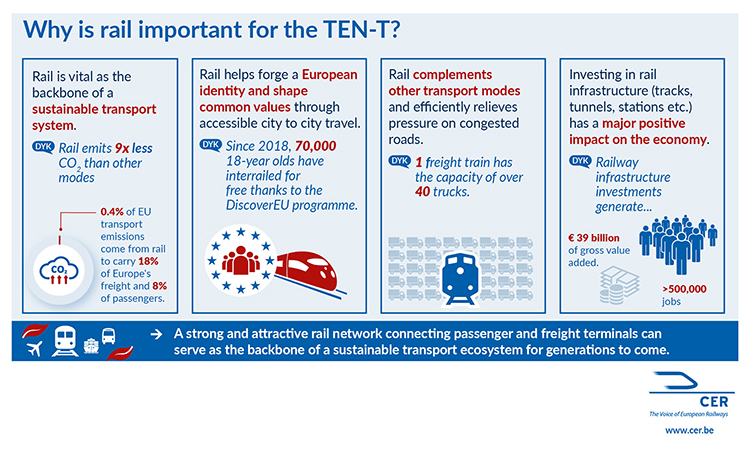

Credit: CER
Another example is the minimum speed for passenger traffic. The proposal introduces a new requirement, a prevailing minimum speed of 160km/h on passenger lines. The implementation of this requirement will not be always feasible and will constitute an increased cost of updating the networks.
ERTMS is one of the few large-scale European digital infrastructures and, as such, should be properly and quickly deployed throughout Europe. However, the proposal also describes a challenging target for ERTMS deployment without stipulating the way to achieve the target system. A future, strong and centralised EU Level ERTMS governance is needed, which governs funding, National Implementation Plans (NIP) planning, resourcing, market uptake, migration, and transition. The ERTMS Coordinator with all the stakeholders must devise and promote such governance.
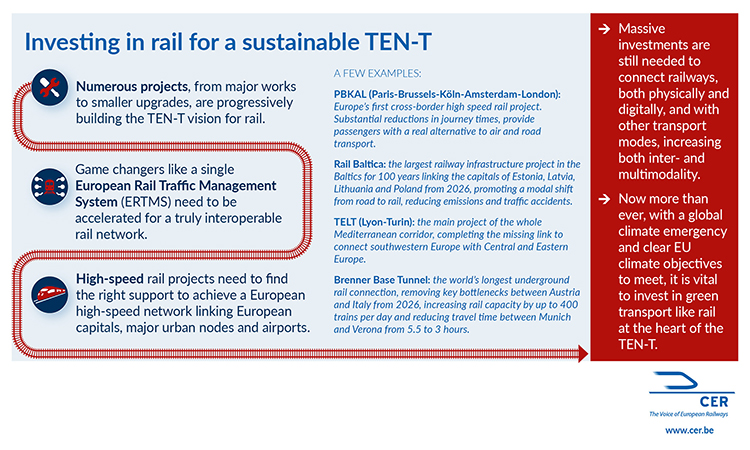

Credit: CER
Finally, the sector believes there is insufficient focus on high-speed rail development in the proposal of the TEN-T regulation. The Sustainable and Smart Mobility Strategy sets ambitious targets in terms of the high-speed network: doubling high‑speed rail traffic by 2030 and tripling it by 2050. With the existing high-speed lines, it is not feasible to achieve such targets. The current network is mainly made up of ‘national high-speed islands’ and, while a lot has been achieved so far with national success stories connecting Paris–Lyon, Milan–Rome, Barcelona–Madrid, and Berlin–Munich among others, there is a growing need to develop an EU High-Speed Network with a larger number of origin-destinations in Europe connecting not only EU capitals but also major cities. A stronger TEN-T promoting climate-friendly alternatives like rail means also promoting the creation of a European high-speed network that is interoperable, linking European capitals and major cities, connecting urban nodes and airports, and supporting the development of international passenger services.
In conclusion
The proposal of the TEN-T regulation is an impetus to make mobility in Europe green and efficient. Without investments in rail infrastructure, there will not be a European Green Deal. The enhanced TEN-T policy, if managed and implemented well, will provide the necessary conditions to shift to zero‑emission mobility. The rail sector is ready to grasp such an impetus before it’s too late.


Issue
Related topics
Cargo, Freight & Heavy-Haul, European Rail Traffic Management System (ERTMS), Infrastructure Developments, Operational Performance, Regulation & Legislation, Sustainability/Decarbonisation
Related organisations
Community of European Railway and Infrastructure Companies (CER), European Commission (EC), European Union (EU)






